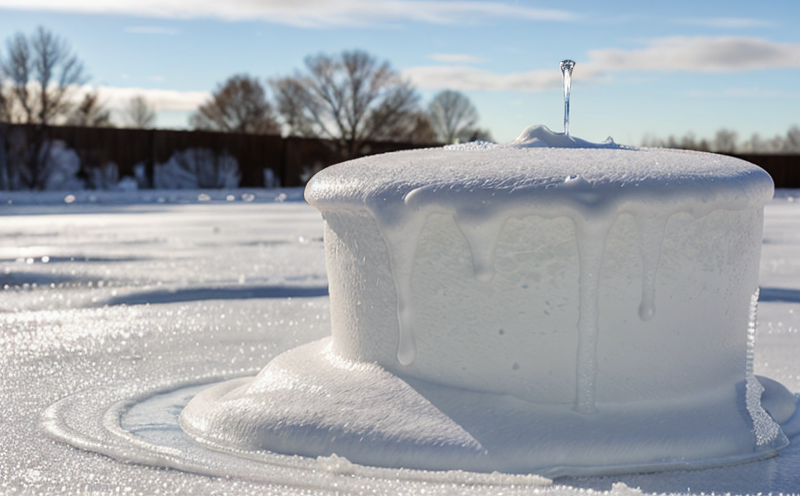SAE ARP 5903 Ice Crystal Icing Test Methods for Engines
The SAE ARP 5903 standard provides comprehensive test methods specifically designed to evaluate the performance of aircraft engines under ice crystal icing conditions. This testing is critical in ensuring that engine systems remain functional and efficient, even when exposed to challenging atmospheric conditions encountered during flight.
Ice crystal icing occurs when water droplets freeze into ice particles within the intake system of an aircraft engine. These ice crystals can accumulate on key components such as compressor blades, leading to a reduction in engine performance or potentially causing catastrophic failure. The SAE ARP 5903 tests simulate these conditions using controlled environments and precise test protocols.
The testing methodology involves subjecting the engine to various concentrations of ice crystal particles while monitoring critical parameters like pressure ratio, temperature, and fuel flow. The goal is to assess how well the engine can withstand these environmental stresses without compromising safety or operational integrity.
Engineers performing SAE ARP 5903 tests must adhere strictly to specified procedures outlined in the standard. This includes setting up the test rig to accurately represent real-world flight conditions, selecting appropriate ice crystal sizes and concentrations, and ensuring that all data collection equipment is properly calibrated. Compliance with these standards ensures accurate results and consistent performance metrics across different engine models.
The process begins by preparing the engine for testing according to manufacturer specifications. This may involve cleaning the intake components or applying protective coatings if necessary. Once prepared, the engine is placed into a specially designed chamber where it can be exposed to controlled levels of ice crystal particles.
During the test, engineers monitor key performance indicators such as thrust output, fuel efficiency, and operational stability. They also record any changes in airflow patterns or vibrations that might indicate structural damage due to icing. After completing each run, detailed reports are generated detailing observed behaviors under various icing conditions.
SAE ARP 5903 tests are essential for manufacturers looking to meet regulatory requirements while developing next-generation engines capable of operating safely and efficiently in extreme weather scenarios. By adhering to these rigorous testing protocols, companies can ensure their products are robust enough to handle the rigors of commercial aviation or military operations.
For those responsible for quality assurance within aerospace manufacturing firms, understanding the nuances of SAE ARP 5903 is crucial. It enables them to stay informed about advancements in testing methodologies and helps identify areas where improvements can be made. Additionally, familiarity with this standard allows procurement teams to select suppliers who meet high-quality standards.
| Engine Type | Test Conditions | Expected Outcomes |
|---|---|---|
| Propulsion Systems | Variable icing concentrations, temperatures | Evaluation of engine response times; identification of potential failure points |
| Turbofan Engines | High-speed airflow simulation | Determination of compressor efficiency under icing conditions |
| Jet Aircraft Engines | Low-pressure environments | Assessment of fuel consumption rates during icing events |
| Regional Jets | Mixing of ice crystals with other particles | Evaluation of anti-icing systems effectiveness |
Applied Standards
The SAE ARP 5903 standard is closely aligned with other international standards such as ISO, ASTM, and EN. These include:
- ISO/TS16724:2018 – Automotive Engineering – Guidelines for Environmental Testing
- ASTM G21-19 – Standard Practice for Determining the Water Resistance of Painted or Coated Specimens Exposed to Simulated Atmospheric Weathering
- EN 15763:2014 – Aircraft Engine Ice Protection Systems - Design and Test Methods
The alignment ensures that tests conducted according to SAE ARP 5903 are consistent with broader industry practices, enhancing reliability across various applications.
Benefits
- Ensures compliance with regulatory requirements.By adhering to SAE ARP 5903, manufacturers can ensure their engines meet all relevant aviation safety standards.
- Enhances engine durability and longevity.Testing under simulated icing conditions helps identify weak points in design, allowing for targeted improvements that extend the useful life of engines.
- Improves fuel efficiency and reduces operational costs.Understanding how icing affects engine performance allows manufacturers to optimize designs for better fuel usage, thereby lowering maintenance expenses over time.
- Facilitates safer flight operations.Engineers gain valuable insights into how icing impacts critical components, which can lead to enhanced safety features and reduced risk during flights in adverse weather conditions.
- Supports innovation by providing reliable data for research and development efforts.Accurate testing results enable developers to explore new materials, manufacturing processes, and technologies that enhance engine performance under icing conditions.





